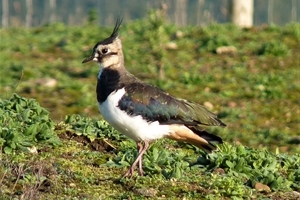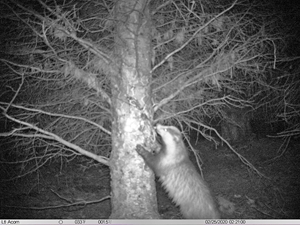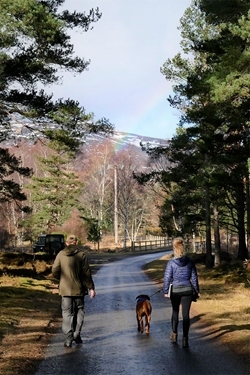By Max Wright, Placement Student, GWSDF
 Living in the middle of nowhere is difficult at the best of times. But when a global pandemic hits and you’re not allowed near civilisation, different challenges arise. Limited to brief once-weekly interactions with our boss and farm research assistant Marlies, and the occasional grunt and wave from the farmer Allan, it would be easy to start losing your mind a bit. Thankfully, spring was on hand, and with the farm springing back into life there was plenty to keep us busy. We have been lucky enough to continue with research monitoring on the farm as we live on it and no travel is required.
Living in the middle of nowhere is difficult at the best of times. But when a global pandemic hits and you’re not allowed near civilisation, different challenges arise. Limited to brief once-weekly interactions with our boss and farm research assistant Marlies, and the occasional grunt and wave from the farmer Allan, it would be easy to start losing your mind a bit. Thankfully, spring was on hand, and with the farm springing back into life there was plenty to keep us busy. We have been lucky enough to continue with research monitoring on the farm as we live on it and no travel is required.
With spring sprung, one of the most exciting additions to the farm was undoubtedly the return of the wading birds. From having lapwing swoop overhead (sounding bizarrely like an old radio transmitter), to seeing the oystercatcher stroll about like they own the place, and being able to (finally) see the curlew about the farm. It is a genuinely rare privilege to see these birds and, in particular, to see them nesting at this time of year. Many of these birds are threatened with extinction and noticeably in decline across much of their range, so seeing them arrive was an exciting uplift from a relatively dreary Scottish winter.
 But the waders are not the only animals active in spring, and with the return of the sun came a variety of other exciting tasks. Not least the thrush surveys. It’s a strange experience hearing what you believe to be a buzzard and looking up to see a male song thrush calling in his territory. As it turns out, song thrush do mimic some other birds’ calls and are apparently particularly fond of sounding like curlew and buzzards. So for the early weeks of spring these little mimics lent us early morning serenades as we did our thrush territory surveys. The other thrush we were commonly able to record were the mistle thrush, blackbird and occasional fieldfare, all with an incredibly diverse range of calls that made deciphering a real challenge at times!
But the waders are not the only animals active in spring, and with the return of the sun came a variety of other exciting tasks. Not least the thrush surveys. It’s a strange experience hearing what you believe to be a buzzard and looking up to see a male song thrush calling in his territory. As it turns out, song thrush do mimic some other birds’ calls and are apparently particularly fond of sounding like curlew and buzzards. So for the early weeks of spring these little mimics lent us early morning serenades as we did our thrush territory surveys. The other thrush we were commonly able to record were the mistle thrush, blackbird and occasional fieldfare, all with an incredibly diverse range of calls that made deciphering a real challenge at times!
One of the other regular jobs we have been tasked with is the monitoring of baited camera traps. These give an important insight as to what predator species are present on the farm and can help build a picture of the whole ecosystem here. Regular visitors included badgers, who preferred pheasant as bait rather than rabbit; plenty of buzzards; and the odd feral cat. Although as well as these we also had occasional visits from the odd fox, tawny owls, and a particularly tenacious jay. And on one exciting day we even had an otter. As well as this, on a variety of other camera traps distributed throughout the farm we also picked up kestrel, red squirrels, and even a wildcat/feral cat hybrid.
 With lambing season fast approaching we are now setting up for when lambing restrictions begin, which coincides with breeding wader activities. During the peak lambing period, our movements and access are reduced so that no stress is caused to the ewes. This means that the tasks at hand are collecting in all the camera traps, which are used on the predator distribution survey, going through all the pictures and then getting the cameras ready for setting over wader nests.
With lambing season fast approaching we are now setting up for when lambing restrictions begin, which coincides with breeding wader activities. During the peak lambing period, our movements and access are reduced so that no stress is caused to the ewes. This means that the tasks at hand are collecting in all the camera traps, which are used on the predator distribution survey, going through all the pictures and then getting the cameras ready for setting over wader nests.
Camera traps are used to monitor wader nest success in areas which researchers cannot access. We are also setting up a radio receiver, which will hopefully collect data from GPS tags, which were attached to lapwing in summer 2019. This data will tell us where each lapwing has travelled over the past year. In past years we have had birds return from the Irish coast, and with little available data on where the birds migrate to after the breeding season, or equally why, when, and which of them return, it’s an intriguing time to be a student research assistant on the farm.
Next stop is nesting, and with any luck the waders and all will have a good year and I’ll be back with updates of a successful breeding season at the end of spring. There is always more to do, and more to come on the farm, and I can’t wait to see what the rest of spring has in store.